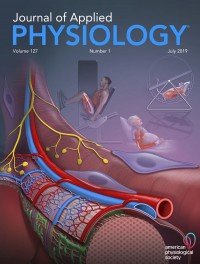Journal of Applied Physiology Q1 Unclaimed
The Journal of Applied Physiology publishes the highest quality original research and reviews that examine novel adaptive and integrative physiological mechanisms in humans and animals that advance the field. The journal encourages the submission of manuscripts that examine the acute and adaptive responses of various organs, tissues, cells and/or molecular pathways to environmental, physiological and/or pathophysiological stressors. It has an SJR impact factor of 1,078.
Journal of Applied Physiology focuses its scope in these topics and keywords: exercise, muscle, skeletal, training, endurance, response, cardiac, expression, flow, model, ...
Type: Journal
Type of Copyright:
Languages: English
Open Access Policy: Open Choice
Type of publications:
Publication frecuency: -


3593.92 €
Inmediate OANPD
Embargoed OA1792.45 €
Non OAMetrics
1,078
SJR Impact factor268
H Index370
Total Docs (Last Year)1008
Total Docs (3 years)15363
Total Refs2920
Total Cites (3 years)888
Citable Docs (3 years)2.77
Cites/Doc (2 years)41.52
Ref/DocOther journals with similar parameters
Circulation Q1
Annual Review of Plant Biology Q1
Annual Review of Physiology Q1
Nature Metabolism Q1
Circulation Research Q1
Compare this journals
Aims and Scope
Best articles by citations
Effects of mass loading the respiratory system in man
View moreMuscle mechanoreceptor modulation of sweat rate during recovery from moderate exercise
View moreEstimation of transmural cardiac pressures during ventilation with PEEP
View moreRole of heat shock protein 27 in cytoskeletal remodeling of the airway smooth muscle cell
View moreIs increased hematopoiesis needed at altitude?
View moreEffects of hyper- and hypoventilation on gastric and sublingual P CO 2
View moreMucociliary and long-term particle clearance in the airways of healthy nonsmoker subjects
View moreSpatial distribution of hypoxic pulmonary vasoconstriction in the supine pig
View moreModeling bronchial circulation with application to soluble gas exchange: description and sensitivity analysis
View moreMechanism of the increased rib cage expansion produced by the diaphragm with abdominal support
View moreRelating maximum airway dilation and subsequent reconstriction to reactivity in human lungs
View moreMild obesity does not limit change in end-expiratory lung volume during cycling in young women
View morePhysiological responses to prolonged bed rest and fluid immersion in humans
View moreViral respiratory infection increases susceptibility of young rats to hypoxia-induced pulmonary edema
View moreARDS-like lung injury produced by endotoxin in platelet-activating factor-primed rats
View moreExercise response after rapid intravenous infusion of saline in healthy humans
View morePeripheral revascularization attenuates the exercise pressor reflex and increases coronary exercise hyperemia in peripheral arterial disease
View moreGas exchange in dogs in the prone and supine positions
View moreDihydropyridine and ryanodine receptor binding after eccentric contractions in mouse skeletal muscle
View moreRegional distribution of ventilation and perfusion as a function of body position.
View moreMechanism by which positive end-expiratory pressure increases cerebrospinal fluid pressure in dogs
View moreFluorescent microsphere method is suitable for chronic bone blood flow measurement: a long-term study after meniscectomy in rabbits
View moreHepatic clearance of indocyanine green in man under thermal and exercise stresses
View moreRole of the glucose cycle in control of net glucose flux in exercising humans
View more
Comments